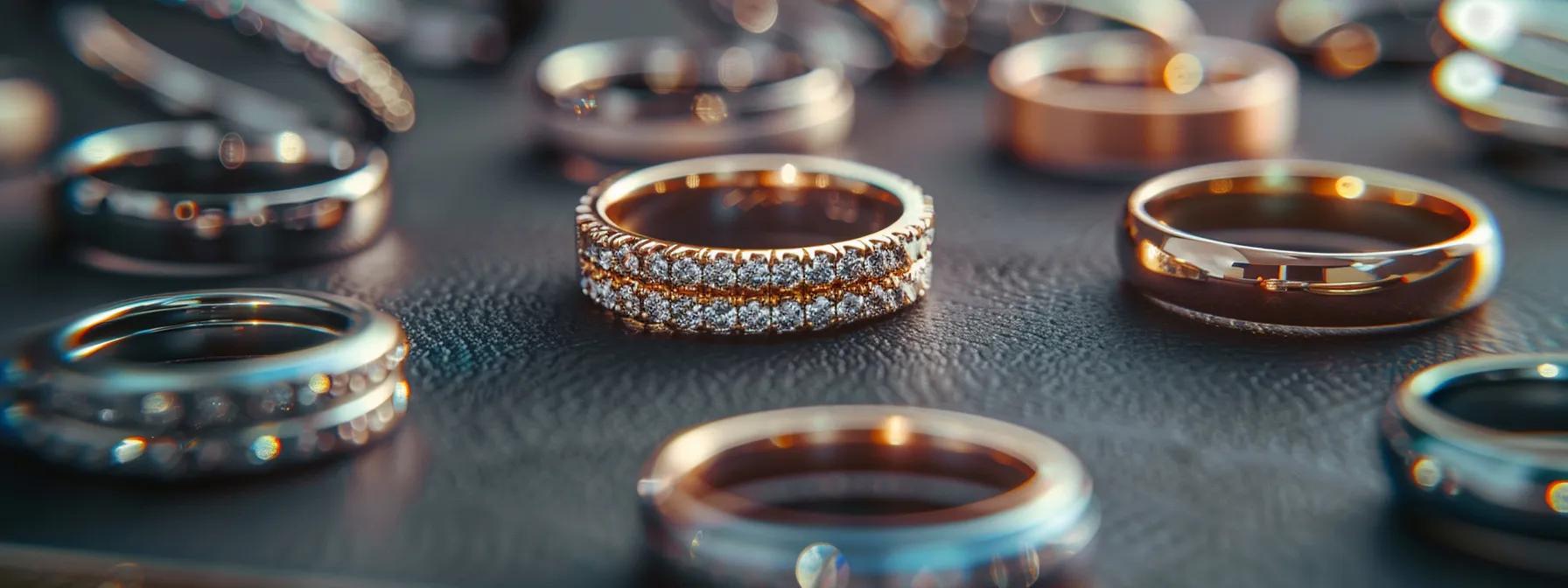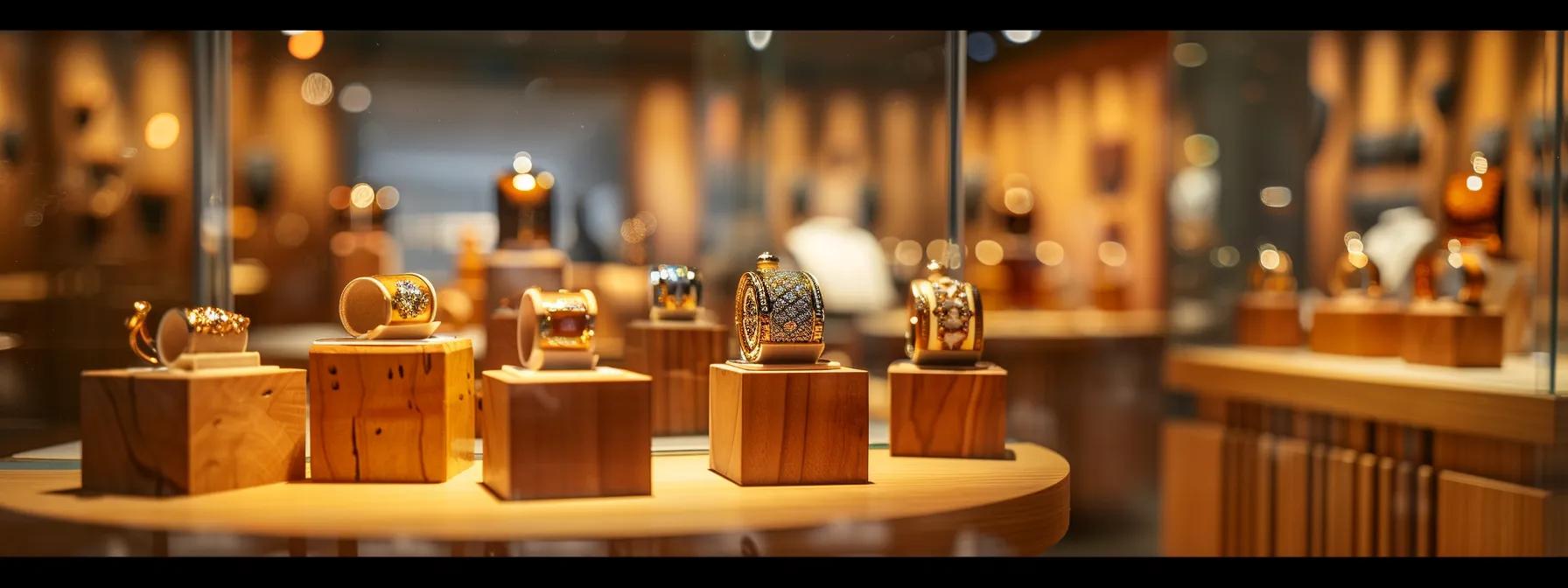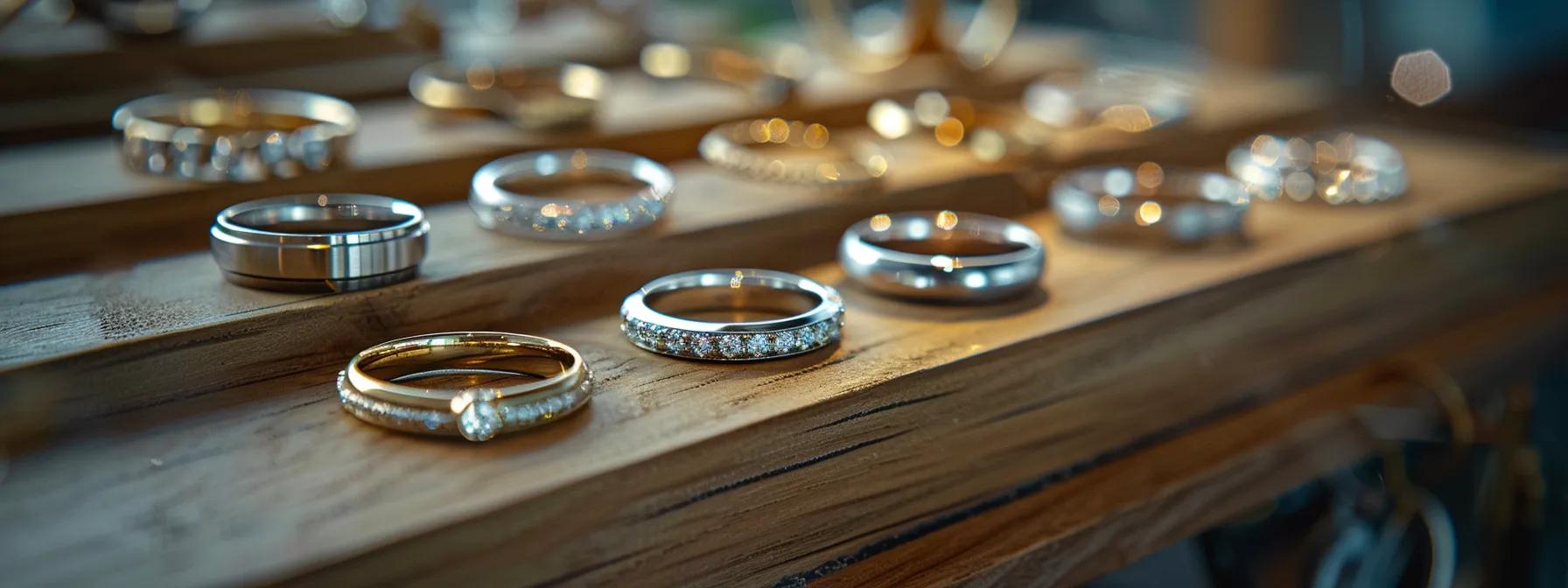In today’s evolving society, alternative wedding rings have emerged as powerful symbols that transcend conventional jewelry. These rings link tradition with modern individuality as couples seek to express their unique identities while honoring cultural heritage. By understanding the nuances behind alternative wedding rings, couples can make informed decisions that honor both their heritage and personal journey. As a professional in the jewelry industry and a guide for those seeking quality men’s rings online, I believe that appreciating the cultural roots of these rings elevates their value beyond merely aesthetics. Let us now examine what alternative wedding rings are and why they matter culturally.
What Are Alternative Wedding Rings and Why Do They Matter Culturally?
Alternative wedding rings deviate from conventional gold or platinum bands by using materials such as wood, ceramic, recycled metals, and even meteorite fragments. These rings are chosen not only for durability and unique design but also for the symbolic meanings they carry. In many cultures, wedding rings represent the eternal bond between partners. Alternative rings expand this symbolism by reflecting individuality, sustainability, and a break from tradition.
These rings allow wearers to tell personal stories—whether highlighting environmental consciousness, historical homage, or simply defying conventional norms. For example, a wooden ring may symbolize natural growth and timelessness, while a ring with a meteorite fragment can suggest a destiny written in the stars. As more couples embrace these designs, they join a growing movement that honors the past while looking forward to a diverse future.
How Do Alternative Rings Differ From Traditional Wedding Rings?
Traditional wedding rings are typically made of noble metals like gold, platinum, or silver and often feature simple, classic designs. In contrast, alternative rings use unconventional materials such as wood, ceramic, tungsten, or lab-grown diamonds. These choices result in rings that not only look different but also carry distinct symbolic meanings. For instance, recycled metal can indicate a commitment to sustainable living, while a meteorite ring may evoke a sense of cosmic destiny.
The crafting techniques for alternative rings also differ. Many artisans blend traditional handcrafting methods with modern technology, allowing for greater personalization. This approach ensures that each ring reflects the couple’s unique love story and values in a way traditional rings might not be able to capture.
Why Are Couples Choosing Alternative Wedding Rings Today?
Modern couples are drawn to alternative wedding rings because these pieces better mirror their lifestyle and personal beliefs. As society increasingly values diversity and individuality, alternative rings offer a more personal touch than standard bands. They can be tailored to incorporate elements representing a couple’s personal journey, shared values, or cultural heritage.
Moreover, many couples find that alternative rings break free from the monotony of mass-produced jewelry. These rings are seen as a celebration of authenticity; they start conversations and serve as a visual representation of modern love—one that is inclusive, innovative, and ethically produced.
What Role Does Symbolism Play in Alternative Wedding Rings?
Symbolism is fundamental to alternative wedding rings. Every element—from the texture of wood symbolizing natural life to the cosmic allure of a meteorite—is imbued with meaning. Such symbolism deepens the emotional connection between the wearer and the ring, elevating it from a mere accessory to a cherished emblem of commitment.
For instance, the use of lab-grown diamonds or recycled metals can embody ethical practices and sustainability, aligning with modern values of social responsibility. Additionally, intricate details like Celtic knots or Viking motifs serve as constant reminders of a couple’s roots and shared history, transforming the ring into an heirloom that carries cultural narratives across generations.
Which Materials Are Used in Alternative Wedding Rings and What Do They Symbolize?

The materials in alternative wedding rings are as varied as the couples who choose them. Each material offers unique physical characteristics and carries rich layers of symbolism that reinforce the ring’s meaning and ethical context.
What Is the Cultural Meaning Behind Wood Wedding Rings?
Wood wedding rings are admired for their organic charm and warm, earthy appeal. They symbolize continuous growth, natural beauty, and the enduring cycle of life—much like the rings seen in trees over the years. Wood signifies a strong connection to nature and one’s roots. Couples who choose wood often value sustainability and the simplicity of natural beauty, underscoring a love that is both enduring and ever-evolving.
The natural grain and imperfections in wood also serve as metaphors for the unique, unpolished truths of human relationships. Each wooden ring is distinct, just as every relationship is unique, making these rings deeply personal and symbolic.
How Do Meteorite Wedding Rings Reflect History and Uniqueness?
Meteorite wedding rings carry an extraordinary narrative. Formed from fragments that have traveled millions of miles across space, these rings evoke a sense of cosmic destiny and mystery. They connect the wearer to the vast universe and remind us that love, like celestial bodies, is unpredictable and rare.
Because no two meteorites are identical, each medalite ring is unique—symbolizing a bond that is one-of-a-kind. Their textured surfaces and natural patterns enhance visual appeal, ensuring that a meteorite ring is both a conversation starter and a lasting heirloom.
What Ethical Considerations Are Linked to Lab-Grown Diamond and Recycled Metal Rings?
Lab-grown diamonds and recycled metal rings have become popular due to their strong ethical and environmental credentials. Lab-grown diamonds possess the same brilliant qualities as natural diamonds yet are created with significantly less ecological disruption and often have transparent supply chains. They represent progress and responsible innovation.
Similarly, recycled metals—whether gold, silver, or platinum—reflect an eco-conscious approach by reducing the environmental impact associated with mining. Choosing these materials signals a dedication to sustainability and responsible consumption, aligning the ring with the values of love, ethics, and environmental stewardship.
How Do Ceramic and Tungsten Rings Represent Durability and Modern Values?
Ceramic and tungsten rings are celebrated for their modern look and lasting durability. Tungsten is known for its strength and scratch-resistant properties, making it ideal for active lifestyles and symbolizing resilience and steadfast commitment. Its polished or matte finish exudes a refined, contemporary aesthetic that appeals to those with modern tastes.
Ceramic rings, engineered for lightweight durability and a high resistance to wear, offer vibrant color options that can reflect personal style while remaining practical. Both materials underline modern values such as efficiency, resilience, and a commitment to progress—qualities that are central to today’s cultural expressions of love.
How Do Design Styles Influence the Cultural Significance of Alternative Wedding Rings?
The design style of an alternative wedding ring heavily influences its cultural significance. Choices regarding etchings, textures, and overall form not only enhance aesthetics but also embed historical, symbolic, and personal meanings in the piece. By embracing diverse design styles, alternative rings become both wearable art and cultural artifacts.
What Is the History and Symbolism of Celtic Wedding Rings?
Celtic wedding rings are renowned for their intricate knotwork and interwoven patterns that symbolize the endless cycle of life and love. The continuous loops in Celtic knots illustrate eternal love and the belief that marital bonds have no beginning or end. Historically, these rings also served as talismans offering protection and good fortune to the wearer.
For many couples, choosing a Celtic design is a tribute to cultural heritage. The detailed engravings and artisan craftsmanship evoke the wisdom of ancestors, blending historical tradition with modern commitment in a way that feels both timeless and profoundly personal.
How Do Viking Wedding Rings Reflect Heritage and Meaning?
Viking wedding rings, inspired by the lore of Norse culture, often feature bold, geometric designs and sometimes incorporate runic symbols. These rings evoke the strength, courage, and adventurous spirit of the Viking era. Their clean lines and robust construction serve as a reminder of resilience and honor.
For many, a Viking ring is more than a piece of jewelry—it is a tribute to ancestral heritage and an emblem of personal strength. The ability to combine modern craftsmanship with ancient symbolism makes these rings appealing to those who value both cultural identity and individuality.
What Does Minimalist and Modern Design Say About Contemporary Values?
Minimalist and modern wedding rings reject excessive ornamentation in favor of clean lines and understated elegance. This design approach reflects contemporary ideals of simplicity, efficiency, and sustainability. By removing the superfluous, minimalist rings emphasize the essential significance of the marital bond.
Often made from innovative materials such as tungsten, ceramic, or even carbon fiber, these rings align with a lifestyle that values functionality and ethical production. Their subtle elegance and focus on quality over flash echo modern priorities—authenticity, restraint, and thoughtful consumption.
How Does Art Deco Design Connect to Cultural Influences in Wedding Rings?
Art Deco rings bring the glamour and optimism of the early 20th century to modern design. Marked by bold geometric shapes, symmetrical patterns, and lavish ornamentation, Art Deco rings combine opulence with functionality. Their detailed filigree and contrasts between polished and matte surfaces evoke a sense of celebration and artistry.
This design style bridges classical grandeur with modern sensibilities, offering couples a ring that is at once vintage and contemporary. Art Deco rings communicate that love, like art, is complex and beautiful—a timeless testament to both tradition and innovation.
What Are the Cultural Traditions Behind Alternative Wedding Rings in Different Communities?

Wedding rings carry deep cultural meanings across various communities, serving not just as tokens of affection but as symbols of commitment, social identity, and heritage. Different cultures infuse their wedding traditions with unique rituals, creating a rich tapestry of meanings and practices.
How Are Wedding Rings Celebrated in Celtic and Viking Cultures?
In Celtic culture, wedding rings are intimately linked with ceremonial rites and symbolic knotwork that represent the interweaving of lives. These rings are often blessed during rituals that celebrate the union of families and the preservation of cultural heritage, serving as protective talismans against misfortune.
Similarly, Viking wedding traditions view rings as emblems of strength and unity. Norse rings, often engraved with runic inscriptions or bold patterns, represent honor and valor. For both traditions, the wedding ring is an enduring symbol that memorializes ancestral practices while embracing contemporary commitment.
What Is the Significance of Alternative Rings in LGBTQ+ Communities?
For many within LGBTQ+ communities, alternative wedding rings provide a means to celebrate love in a way that is inclusive and personal. Traditional symbols of marriage were once exclusionary; today, alternative rings—crafted from unconventional materials and featuring innovative designs—affirm diversity, acceptance, and individuality. In this context, the ring becomes both a personal statement and a political symbol of equality and freedom, marking a shift in societal understanding of commitment.
How Do Indigenous Cultures Incorporate Alternative Wedding Rings?
Indigenous communities often imbue wedding rings with profound spiritual significance, using local materials and traditional motifs to reflect their connection to the land and ancestral wisdom. Such rings may feature hand-carved symbols or incorporate natural elements like wood and stone. The communal process of crafting these rings reinforces collective identity and respects sustainable practices, making the ring a living artifact that honors both heritage and nature.
How Do Ethical and Sustainable Practices Enhance the Cultural Value of Alternative Wedding Rings?
Ethical and sustainable practices are now central to modern jewelry production. Consumers increasingly demand transparency and accountability, and alternative wedding rings are no exception. By utilizing ethical sourcing, recycled materials, and sustainable production methods, these rings become symbols not only of love but also of environmental and social responsibility.
Why Are Conflict-Free Diamonds Important in Alternative Wedding Rings?
Conflict-free diamonds ensure that a ring is free from the human rights abuses and environmental harm often associated with traditional diamond mining. Their incorporation into alternative rings underscores a commitment to ethical sourcing and transparency. For couples, knowing that their ring supports social justice adds profound ethical value to an already resonant symbol of love and unity.
How Do Sustainable Materials Reflect Modern Cultural Values?
Using sustainable materials like recycled metals and lab-grown diamonds reflects modern values centered on environmental stewardship and resource conservation. These choices reduce the overall ecological footprint of jewelry production while reinforcing the message that love can coexist with ethical consumption practices. Couples who choose sustainable options demonstrate a balanced commitment to both their personal bond and the broader health of the planet.
What Role Does Fair Trade Play in Supporting Cultural Artisans?
Fair Trade practices ensure that artisans receive fair wages and work in safe conditions, preserving traditional craftsmanship and supporting local communities. Rings produced under these standards not only showcase cultural identity but also tell a story of empowerment and community resilience. For many couples, a Fair Trade ring is a powerful symbol of ethical commitment and respect for cultural heritage.
How Can Couples Personalize Alternative Wedding Rings to Reflect Their Unique Cultural Stories?

Personalization is a key appeal of alternative wedding rings. Modern couples often seek rings that capture the unique narrative of their love—integrating elements of heritage, shared values, and personal milestones into a single, intimate piece of jewelry. Customization transforms a ring from a generic accessory into a personal testament to a couple’s journey together.
What Customization Options Highlight Cultural Symbolism?
Couples can enhance the cultural significance of their rings through personalized engravings, custom inlays, and motifs that reflect traditional symbols like Celtic knots, indigenous patterns, or Viking runes. Options such as incorporating ethically sourced wood accents, lab-grown diamond details, or recycled metal inlays allow the ring to become a layered narrative of familial legacy, cultural identity, and personal history.
How Does Personal Storytelling Influence Ring Choice and Meaning?
Personal storytelling remains at the forefront of ring design. Every material choice, engraving, or design element can recount a chapter of the couple’s shared experience—from incorporating a family heirloom to using recycled metal from a place of personal significance. This process of thoughtful customization ensures that the ring is not only aesthetically unique but also deeply meaningful, embodying the couple’s past, present, and future.
What Expert Advice Helps Couples Choose Culturally Significant Rings?
Expert guidance from professional jewelers and cultural consultants can be invaluable. They assist by clarifying which symbols best resonate with a couple’s heritage and by ensuring that every design element—from material selection to intricate engravings—is thoughtfully curated. Their expertise helps create a ring that is both visually striking and rich in cultural significance, aligning perfectly with the couple’s vision and values.
What Care and Maintenance Practices Preserve the Cultural Integrity of Alternative Wedding Rings?
Proper care and maintenance are essential to preserving both the beauty and the cultural significance of alternative wedding rings. Unlike traditional bands, rings made from unconventional materials often require specialized care routines to maintain their appearance and longevity over time.
How Should Wood and Meteorite Rings Be Maintained for Longevity?
Wood rings need regular oiling with a natural, non-toxic conditioner to preserve their moisture and prevent cracking, while also being kept away from prolonged exposure to water or extreme temperatures. Meteorite rings, with their delicate textures, should be gently cleaned using a soft cloth and mild, non-abrasive cleaner to avoid damaging their unique patterns. These tailored care practices help maintain the ring’s integrity as a long-lasting symbol of cultural heritage.
What Are Best Practices for Caring for Ethical and Lab-Grown Diamond Rings?
Ethical and lab-grown diamond rings benefit from discreet maintenance. Regular cleaning with a soft-bristle brush, warm water, and mild soap helps remove dust and oils without harming the metal or compromising the diamond’s facets. Avoiding abrasive cleaning methods such as ultrasonic or steam cleaners is generally recommended unless deemed safe by a professional jeweler. Routine inspections also ensure that any minor issues are addressed before they affect the ring’s overall durability.
How Does Proper Maintenance Enhance the Symbolic Value of Rings?
A well-maintained ring not only stays physically pristine but also continuously reflects the enduring nature of the couple’s relationship. Regular cleaning, prompt repairs, and careful storage affirm the commitment to preserving the ring’s cultural and ethical significance, transforming it into a timeless ritual artifact that tells an ongoing story of love and responsibility.
Frequently Asked Questions
Q: What makes alternative wedding rings culturally significant? A: They incorporate unique materials and designs that embody personal narratives, ethical values, and diverse cultural heritage, offering symbols of sustainability and non-conformity that connect deeply with both ancestral and modern identities.
Q: How do alternative rings differ from traditional wedding rings? A: Alternative rings use unconventional materials such as wood, meteorite, ceramic, or lab-grown diamonds and emphasize personalization and distinctive cultural symbolism, unlike traditional bands which typically feature standard noble metals and classical designs.
Q: Are ethical alternatives like lab-grown diamonds as durable as natural ones? A: Yes, lab-grown diamonds have the same physical, chemical, and optical properties as natural diamonds; they offer comparable durability while being produced more sustainably and ethically.
Q: What customization options are available for alternative wedding rings? A: Options include personalized engravings, custom inlays, and the integration of culturally significant symbols like Celtic knots, indigenous motifs, or Viking runes, along with accents of ethically sourced wood or recycled metals.
Q: How can I maintain my alternative wedding ring to preserve its appearance and symbolism? A: Use material-specific care routines—conditioning for wood, gentle cleaning for meteorite, and regular professional inspections for ethical and lab-grown diamond rings—to keep the ring pristine and symbolically potent.
Q: What role do Fair Trade practices play in the production of alternative wedding rings? A: Fair Trade ensures ethical production by supporting artisans with fair wages and safe conditions, preserving traditional craftsmanship, and aligning the ring’s creation with values of social and environmental responsibility.
Q: How do cultural traditions influence the design of alternative wedding rings? A: Cultural traditions infuse rings with symbols—whether through intricate Celtic knots, Viking runic inscriptions, or indigenous motifs—that create a rich tapestry of historical and personal identity, making each ring a lasting homage to its wearer’s heritage.
Final Thoughts
The evolution of wedding rings into alternative forms represents a compelling fusion of tradition and modern values. By embracing non-conventional materials and innovative designs, couples create rings that do more than symbolize eternal union—they express commitments to sustainability, ethical practices, and personal storytelling. The diverse cultural influences embedded in these rings remind us that love is not only an intimate bond but also a celebration of heritage and responsibility. As you choose a ring that resonates with your unique journey, consider the harmonious blend of symbolism and innovation that alternative wedding rings have to offer.

